Tourism in Switzerland
Tourists are drawn to Switzerland's diverse landscape as well as activities. Most interesting are the Alpine climate and landscapes, in particular for skiing and mountaineering.
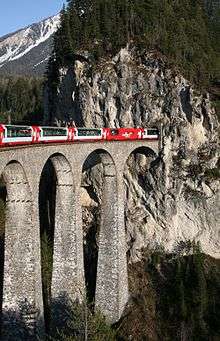
As of 2016, tourism accounted for an estimated 2.6% (CHF 16.8 billion) of Switzerland's gross domestic product, down from 2.6% (CHF 12.8 billion) in 2001.[1]
History

Tourism begins with British mountaineers climbing the main peaks of the Bernese Alps in the early 19th century (Jungfrau 1811, Finsteraarhorn 1812). The Alpine Club in London was founded in 1857. Reconvalescence in the Alpine climate, in particular from Tuberculosis, is another important branch of tourism in the 19th and early 20th centuries for example in Davos, Graubünden. Due to the prominence of the Bernese Alps in British mountaineering, the Bernese Oberland was long especially known as a tourist destination. Meiringen's Reichenbach Falls achieved literary fame as it was the site of the fictional death of Sir Arthur Conan Doyle's Sherlock Holmes (1893). The first organised tourist holidays to Switzerland were offered during the 19th century by the Thomas Cook and Lunn Travel companies.
Statistics
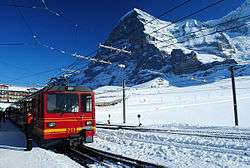
Official statistics of tourism were planned since 1852, but were only realized from 1934, and continued until 2003. Since 2004, the Federal Statistical Office had discontinued its own statistics, but collaborates with Switzerland Tourism in the publication of yearly "Swiss Tourism Figures". In the year 2011 as a total number of 4,967 registered hotels or hostels, offering a total of 240,000 beds in 128,000 rooms. This capacity was saturated to 41.7% (compared to 39.7% in 2005), amounting to a total of 38.8 million lodging nights. 14% of hotels were in Grisons, 12% each in the Valais and Eastern Switzerland, 11% in Central Switzerland and 9% in the Bernese Oberland. The ratio of lodging nights in relation to resident population ("tourism intensity", a measure for the relative importance of tourism to local economy) was largest in Grisons (8.3) and Bernese Oberland (5.3), compared to a Swiss average of 1.3. 56.4% of lodging nights were by visitors from abroad (broken down by nationality: 16.5% Germany, 6.3% United Kingdom, 4.8% United States, 3.6% France, 3.0% Italy).[3]
The total financial volume associated with tourism, including transportation, is estimated to CHF 35.5 billion (as of 2010) although some of this comes from fuel tax and sales of motorway vignettes. The total gross value added from tourism is 14.9 billion. Tourism provides a total of 144,838 full time equivalent jobs in the entire country. The total financial volume of tourist lodging is 5.19 billion CHF and eating at the lodging provides an additional 5.19 billion. The total gross value added of 14.9 billion is about 2.9% of Switzerland's 2010 nominal GDP of 550.57 billion CHF.[4][5]
The most visited Swiss tourist attractions are first, the Rhine Falls, second, the Berne Bear exhibit (both without entrance fee), and third, with over 1.8 million paid entries: Zoo Basel.
Overnight stays by country
Most overnight stays in 2014 in Switzerland were from the following countries of residence:[6]
| Rank | Country | Number of overnight stays |
|---|---|---|
| 1 | 4,394,457 | |
| 2 | 1,667,437 | |
| 3 | 1,644,424 | |
| 4 | 1,337,882 | |
| 5 | 1,142,438 | |
| 6 | 1,014,058 | |
| 7 | 770,725 | |
| 8 | 681,671 | |
| 9 | 532,775 | |
| 10 | 508,264 | |
| Total foreign | 19,907,377 |
Destinations
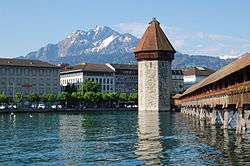
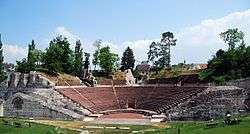
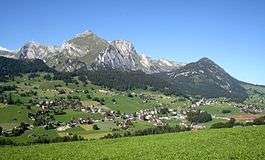
Notable tourist destinations in Switzerland:
- Cities
.jpg)
- Other
Lauterbrunnen ( Alpine meadows and peaks, such as Schilthorn, Bietenhorn, Schwarzmönch, and Silberhorn, and the villages Lauterbrunnen, Wengen, Mürren, Gimmelwald, Stechelberg, and Isenfluh)

- Lake Constance (Bodensee), cantons of Thurgau, St Gallen and Schaffhausen.
- Rhine Falls (Schaffhausen SH)
See also
Notes and references
- bfs.admin.ch, bazonline.ch 23 February 2018.
- Jungfraubahn Holding AG
- Switzerland Tourism, "Swiss Tourism in Figures - 2007 PDF Archived 2012-03-31 at the Wayback Machine"
- Tourism, Federal Statistical Office (Switzerland) (page visited on 7 May 2012).
- SECO Gross domestic product - quarterly estimates Archived 2010-09-23 at the Wayback Machine (page visited on 7 May 2012).
- (in German) Wieder ein Besucherrekord im Zolli. Basler Zeitung, published 2013-2-21, retrieved 2013-2-21
Bibliography
- (in French) Christophe Clivaz, Tourisme d'hiver, le défi climatique [literally, "Winter tourism, the climate challenge"], Presses polytechniques et universitaires romandes, collection "Le Savoir suisse", 144 pages, 2015 (ISBN 9782889151516).
- Tourism in German, French and Italian in the online Historical Dictionary of Switzerland.
External links
| Wikivoyage has a travel guide for Switzerland. |
![]()
- Switzerland Tourism, a national tourism organisation
- Switzerland travel and tourism at Curlie
.svg.png)